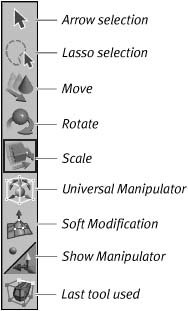Chapter 4. Transforming Objects and Components
| Maya gives you many ways to move, rotate, and scale objects around a scene, and many shortcuts for completing these common tasks. These actions, known as transformations, can be performed in a couple of different ways: You can type new coordinates or values in the Channel Box or use one of the many manipulation tools (Figure 4.1) to drag the object freely around the scene or constrain it to an axis. Figure 4.1. Maya's manipulation tools. Using the same tools you would employ to manipulate objects in the scene, you can also manipulate parts of an object, known as components. Each object type has its own components that can be translated (Figure 4.2), rotated, and/or scaled to change their look and position, in turn changing the appearance of the object. Figure 4.2. The Move tool's Translation manipulator is used to move objects and components around the scene. Most tools include advanced features (shown in the Tool Options) that you can explore as your knowledge base grows. The duplication options provide a good example of this. Once you get used to using them, you can employ a number of advanced options like duplicating an object multiple times throughout your scene, or using them to construct and mirror objects. |
EAN: 2147483647
Pages: 185

